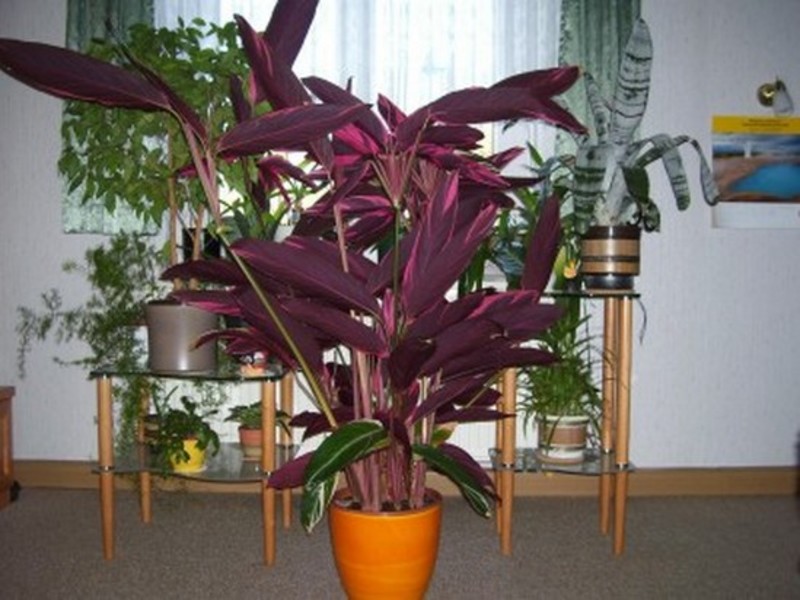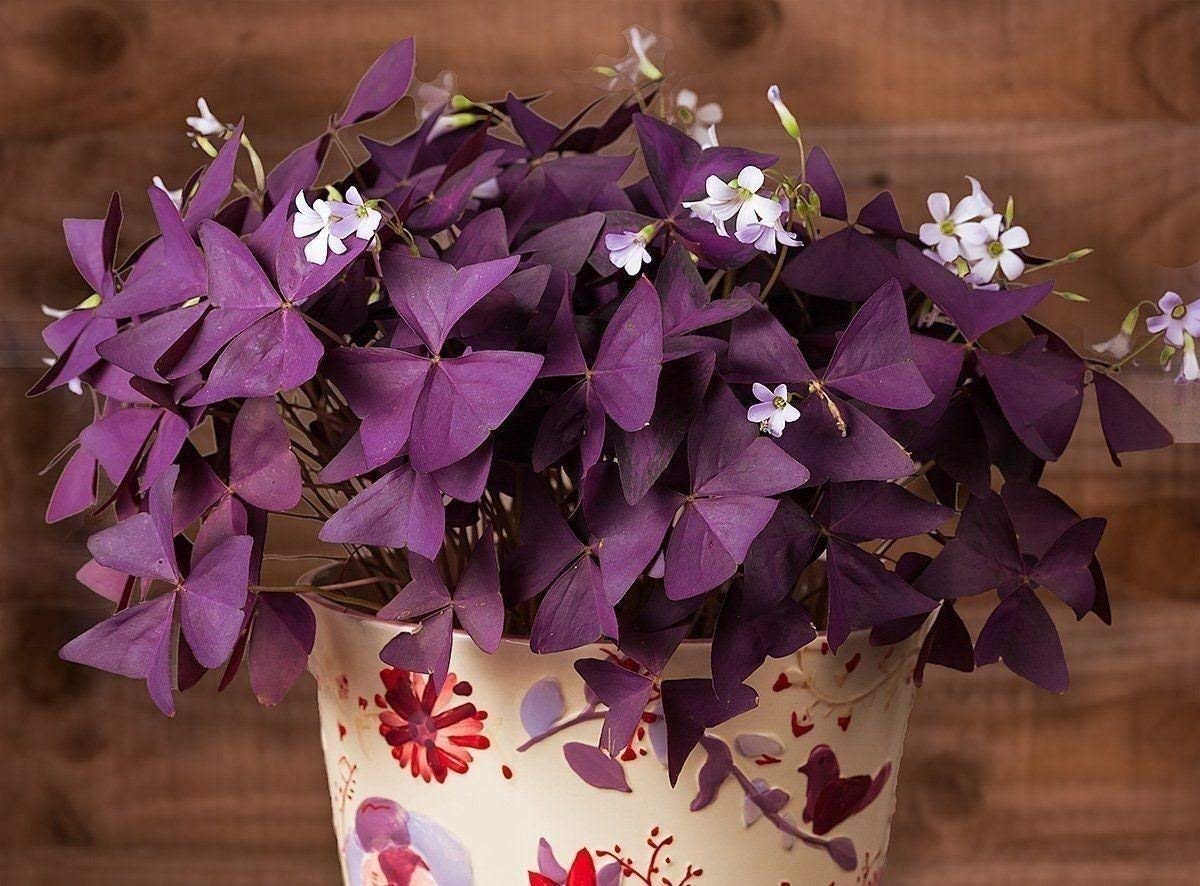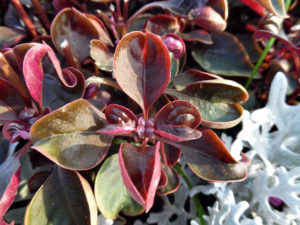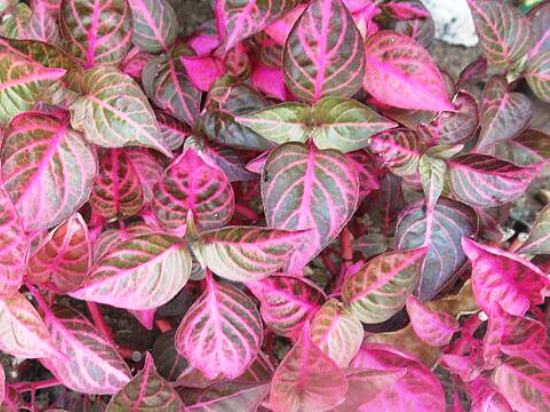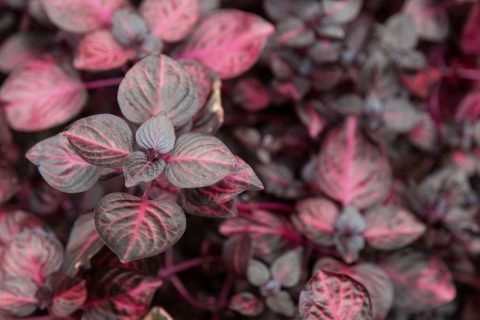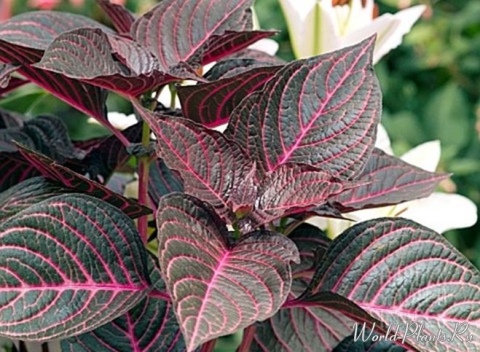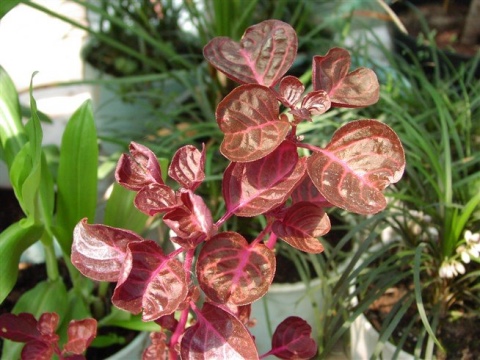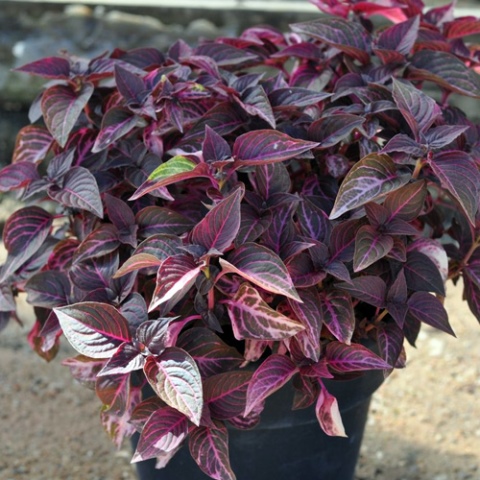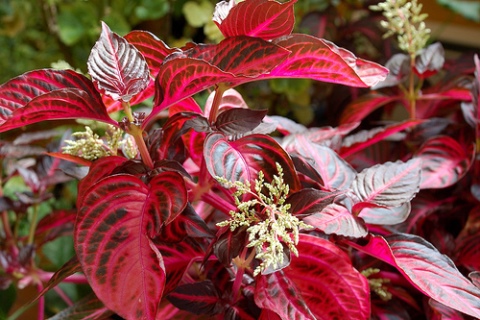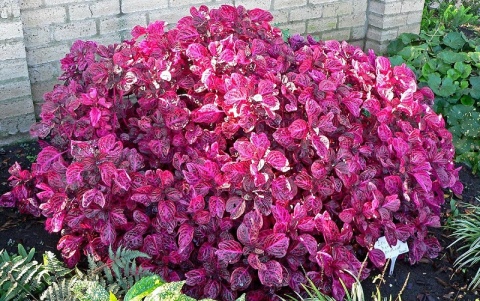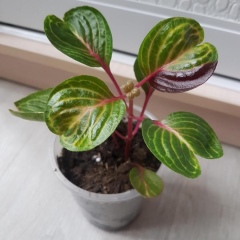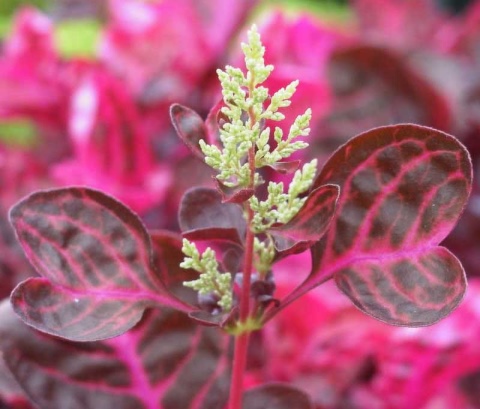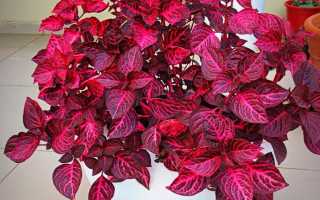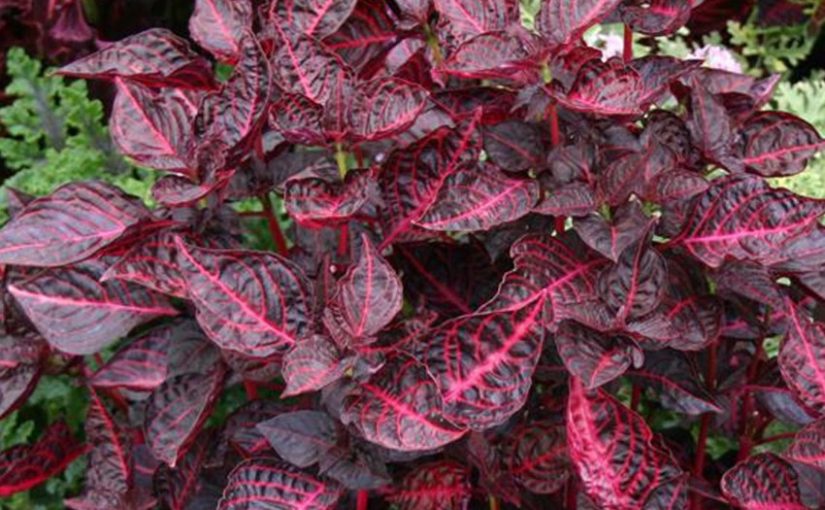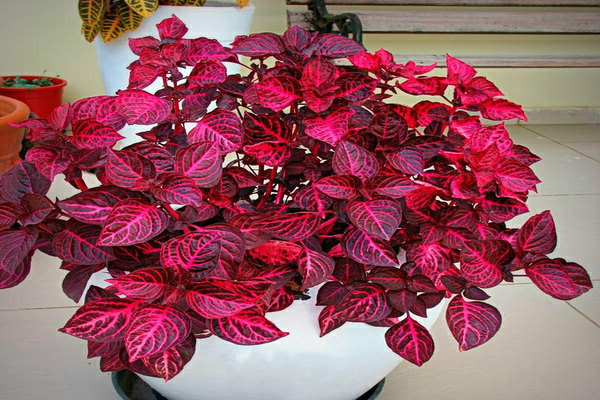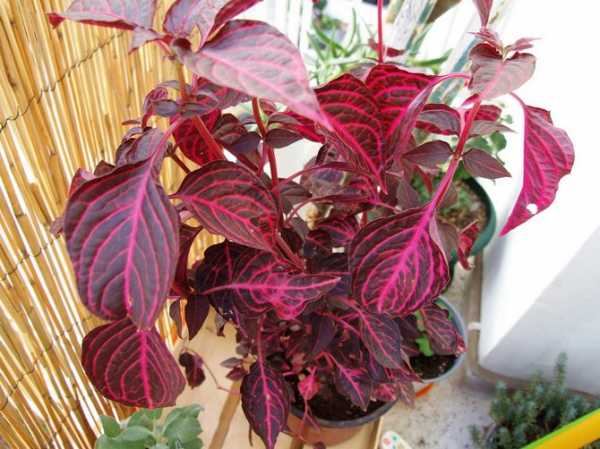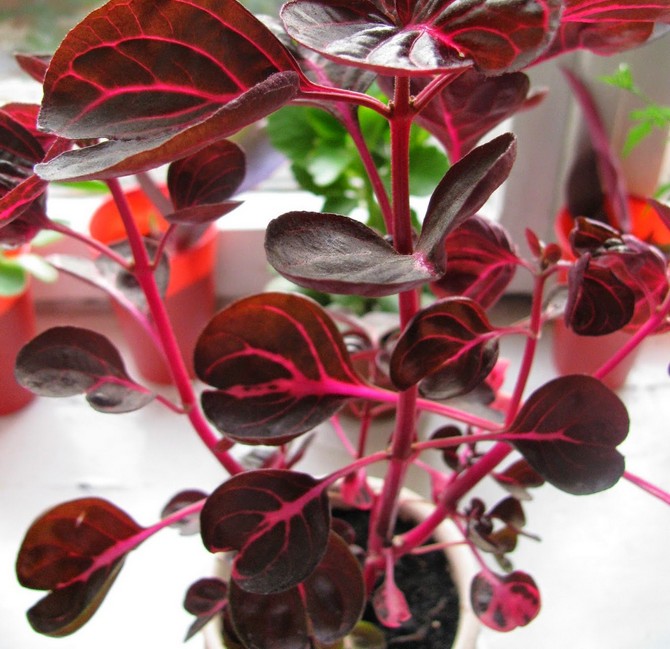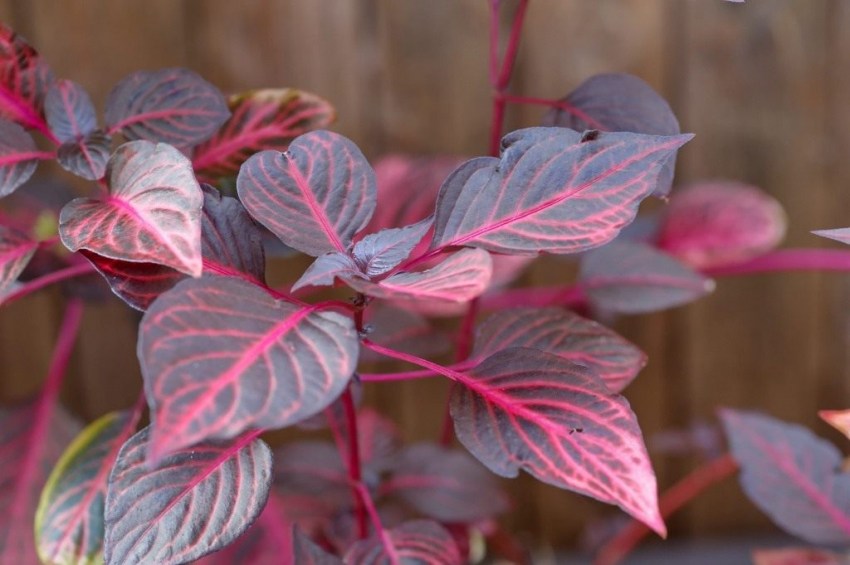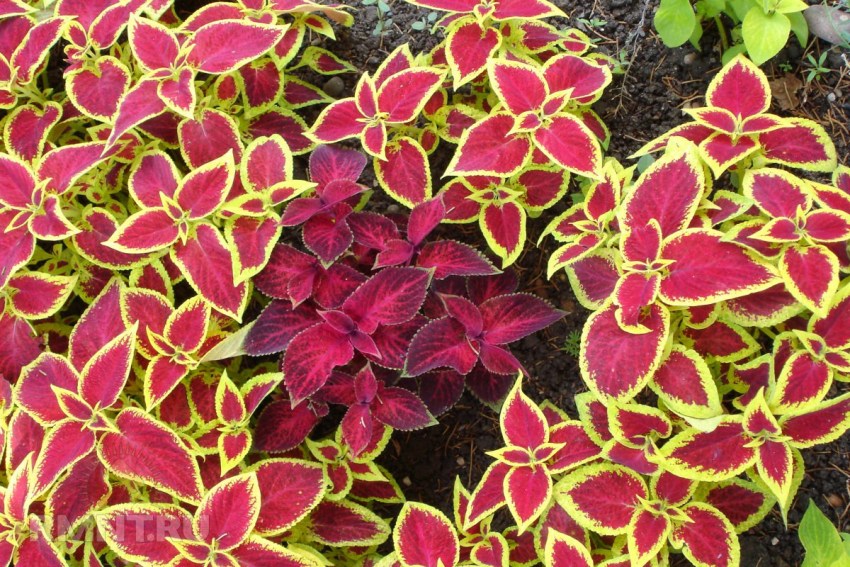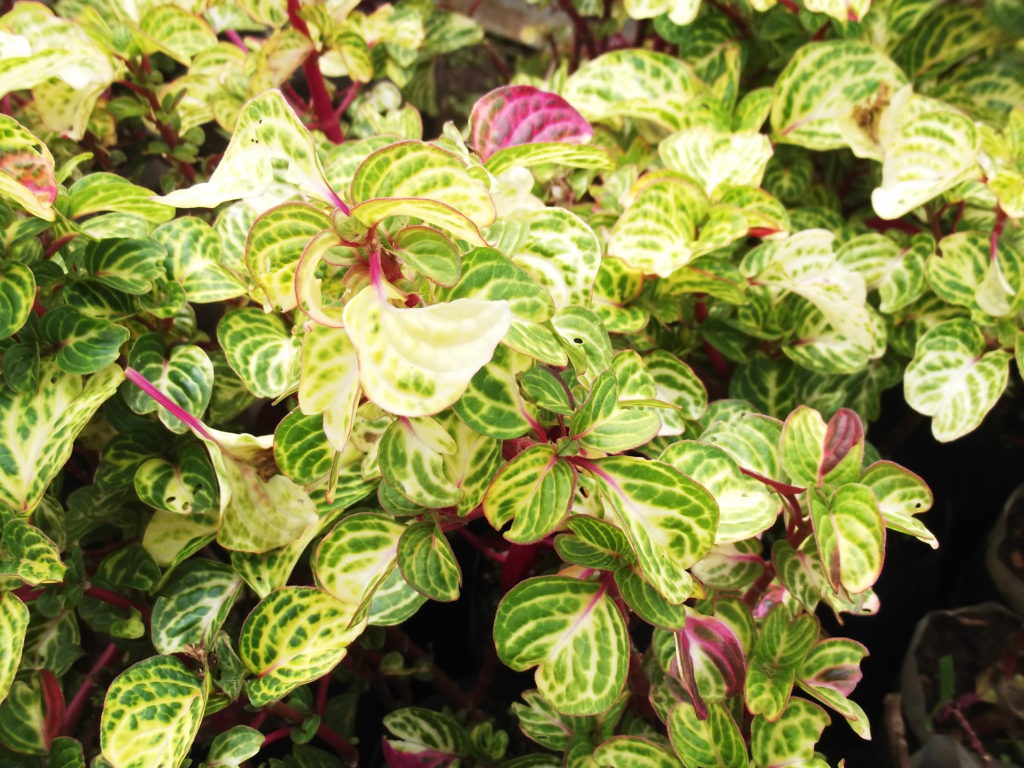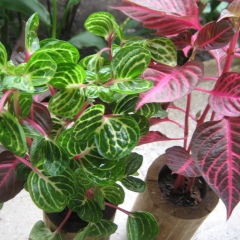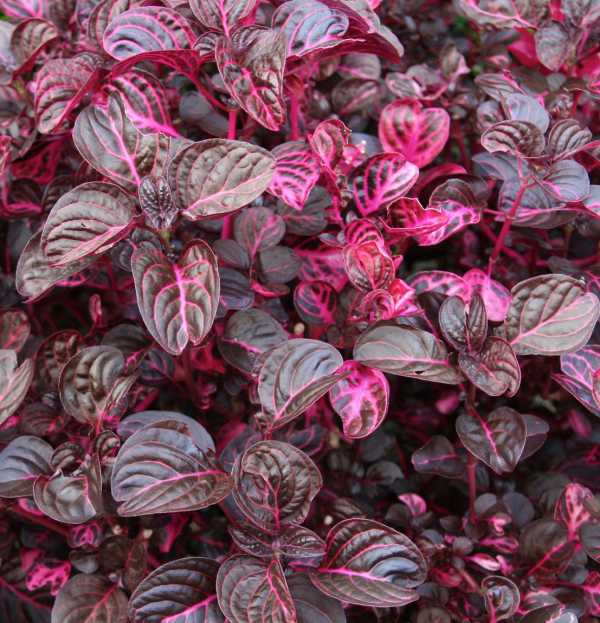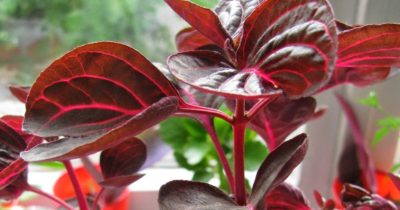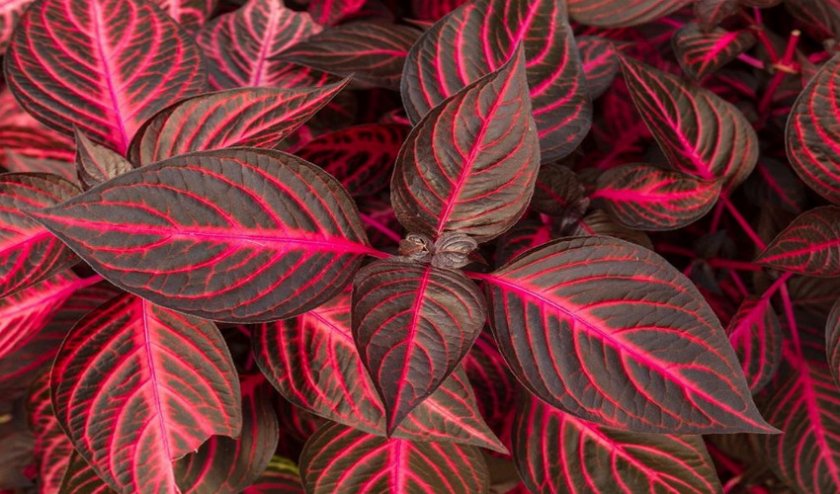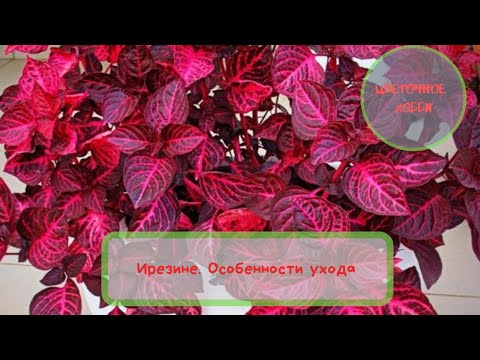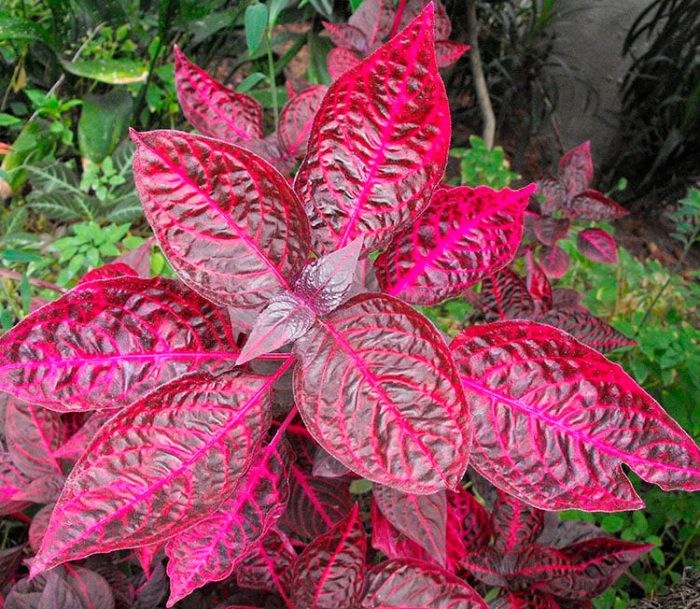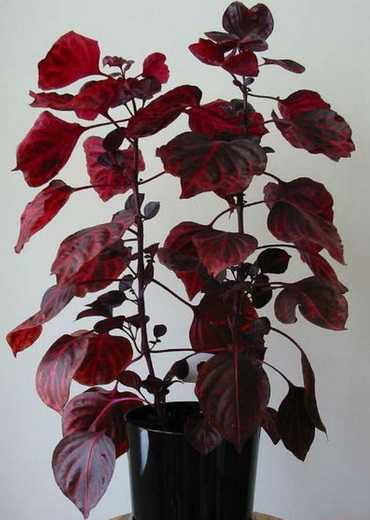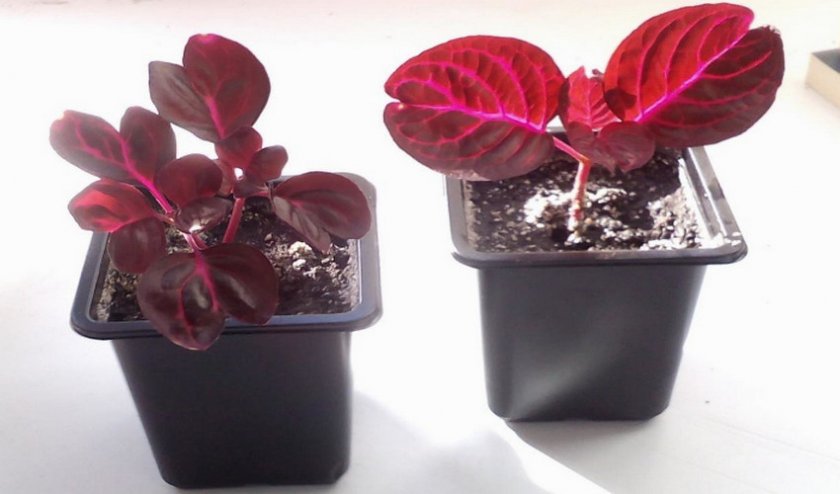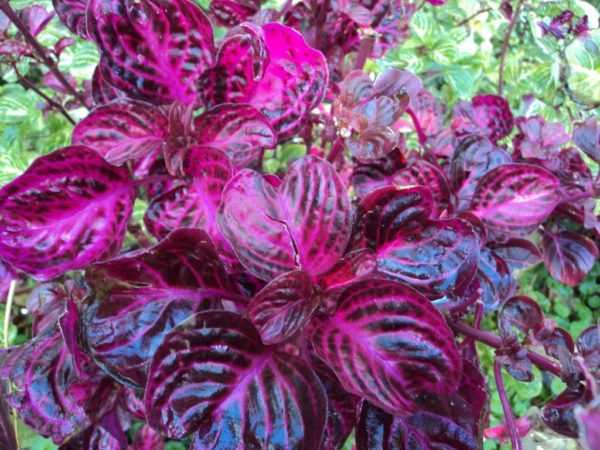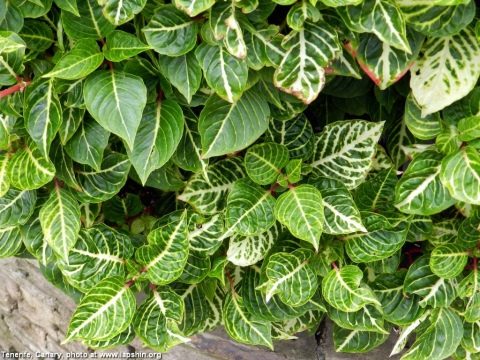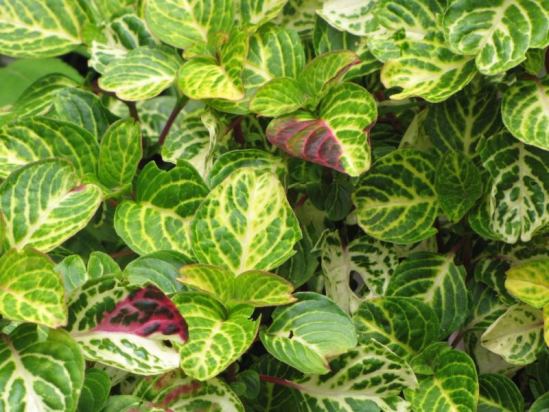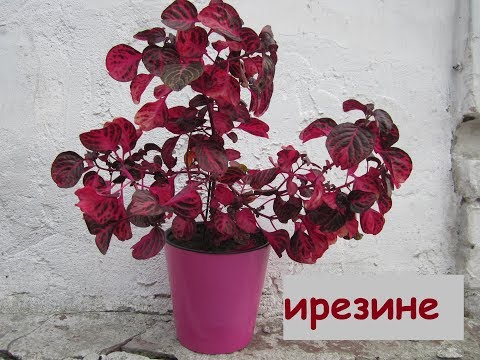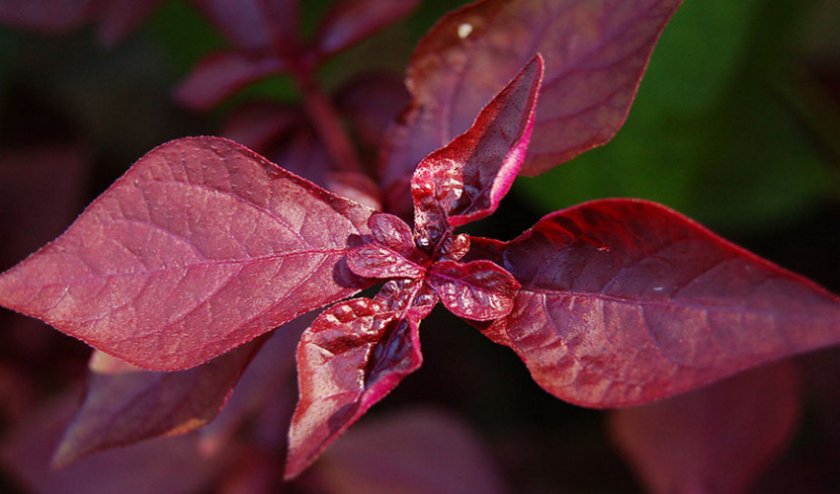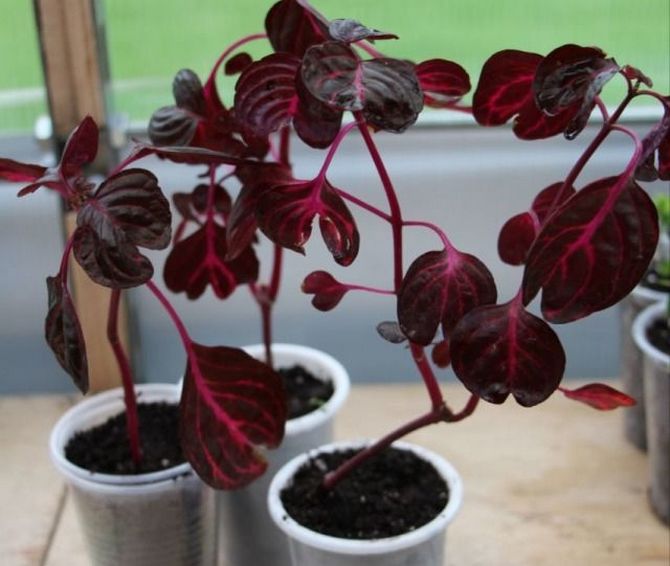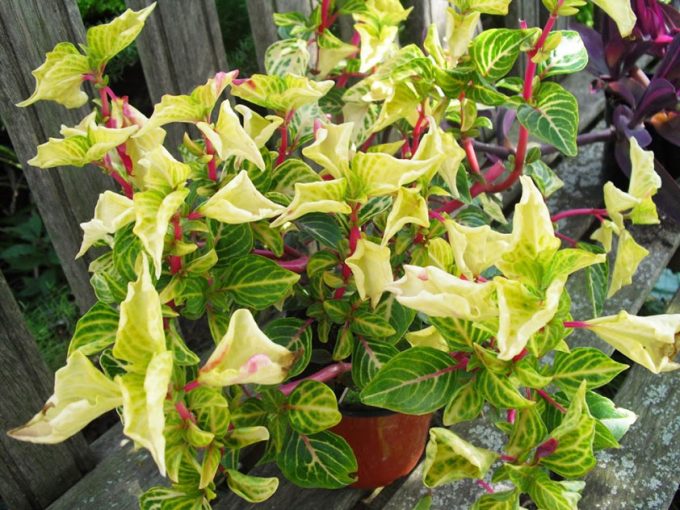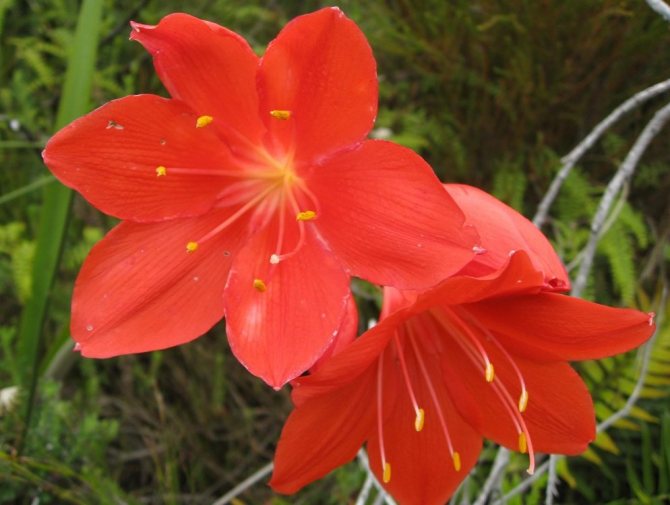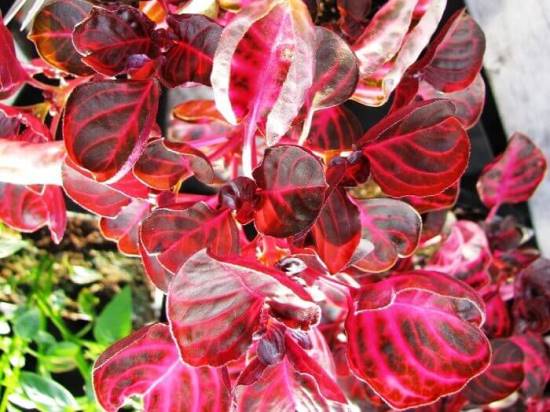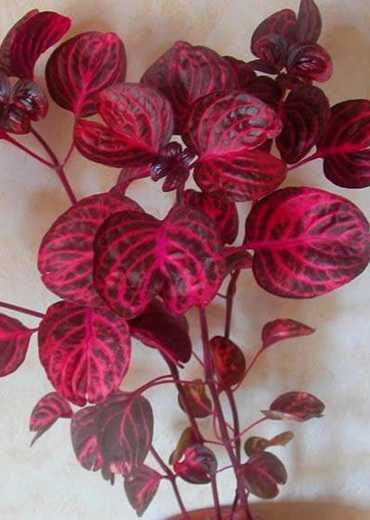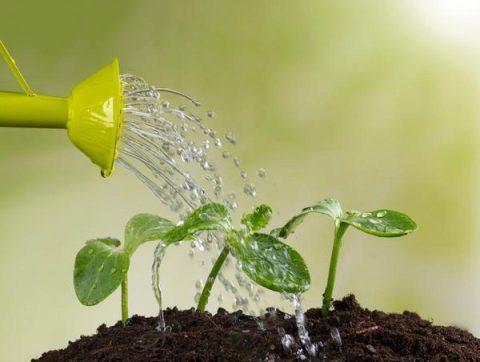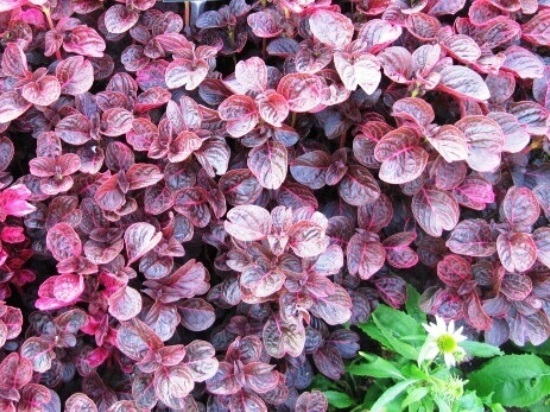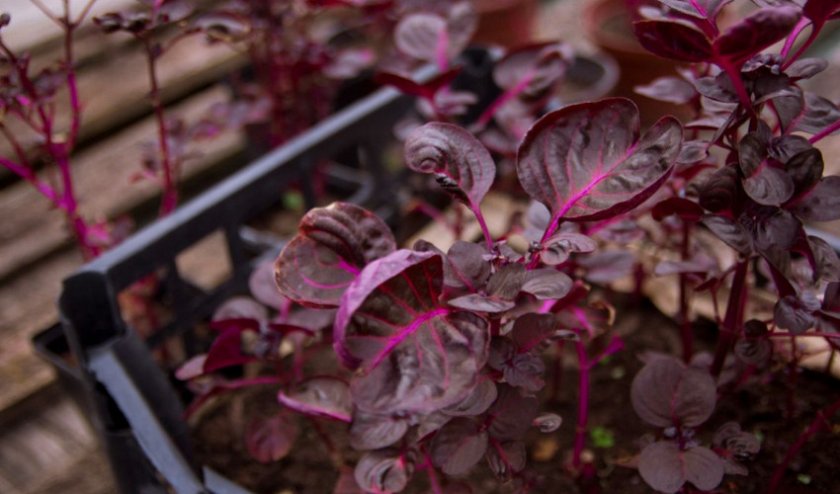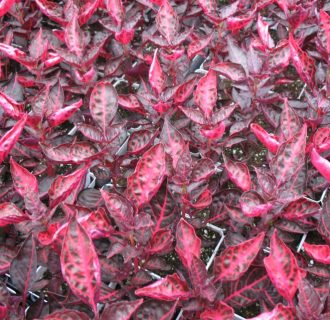Reproduction
Most often, the plant is propagated by cuttings, and sometimes by sowing seeds. It is best to cut in February, March or April. The apical cuttings about ten centimeters long are pinched and planted in the sand. During rooting, the temperature must be maintained around sixteen to twenty-two degrees Celsius. In ten days the cuttings take root.
After rooting, the seedlings are transplanted into pots one at a time. The height of the pot is about seven centimeters. The soil should contain turf, leaf and humus soil, as well as sand.
Main types
Iresine lindenii
Such a herbaceous perennial plant naturally occurs in the humid forests of tropical Ecuador. The stem is dark red and slightly over 50 centimeters tall. On the surface of the dark red leaf plates, there are many thin veins with a rich crimson color. The length of such lanceolate-oval leaves reaches 6 centimeters. If you trim the plant, then it begins to branch rather strongly, while the young shoots of the leaves grow relatively quickly.
Iresine herbstii
Such a perennial herb is found naturally in the rainforests of tropical Brazil. The stems are red in color and can reach a height of about 40 centimeters. Rounded leaf plates in the upper part have a heart-shaped shape. The leaves are painted in a dark purple color, and rich red veins are located on their surface. Variety "aureoreticulata" is distinguished by red shoots and leaf stalks. Red or golden veins are located on green leaf plates. The "wallisi" cultivar is a compact, rather branched plant with small leaves of a metallic red color.
Irezine (lat. Iresine) or irezina is a herbaceous, shrub or semi-shrub perennial of the Amaranth family, originally from America, Australia, the Galapagos and Antilles.
The name of this houseplant is translated from Greek as "woolen", probably due to the abundant pubescence of its flowers and fruits.
The plant is not poisonous and cleans well and oxygenates the air in the room.
Possible problems

- With improper watering, irezine leaves fall off. This occurs both from a lack of moisture in the soil and from excess.
- Due to the lack of light, the branches become thin and strongly elongated. At the same time, the contrast of the colors of the leaves is also lost.
- If you do not prune in time, then leaves will begin to crumble from young branches.
- Irezine can infect spider mites, aphids, whiteflies and mealybugs. At home, this comes from improper care. If the bush grows in the garden and it is affected by harmful insects, then the reason for this is the weather conditions. Soap solution and subsequent insecticide treatment will help you get rid of parasites. After that, be sure to rinse the plant with warm water.
- On hot summer days, when the ambient temperature is above 28 degrees, spray the flower more often and water more abundantly. Otherwise, the brightness of the colors of the leaves will be lost.
Botanical description
Most irezine plants are herbaceous annuals or perennials. The smaller part is climbing or free-standing dwarf shrubs or shrubs.
Aerial parts are smooth or hairy, usually wholly or partly red in color, which is imparted by betacyanin pigment.
Alternate or opposite leaves are divided into petioles and simple plates. They are solid-edged or serrated.
Plants are mainly dioecious.Many small, inconspicuous flowers are collected in lateral capitate or terminal paniculate, complex and open inflorescences.
Bracts are leathery, shiny. Five petals are loose or fused at the base.
Fruits are globular to flattened, containing only one seed, dark red to reddish brown, lenticular to kidney-shaped.
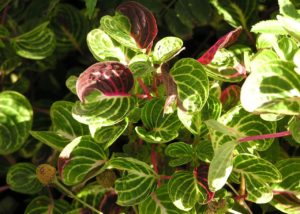
Irezine - shrub or semi-shrub
Home care
There are several important rules regarding indoor culture.
Illumination
Irezine is a light-loving plant, therefore it is recommended to place it on all sides of the house, with the exception of the northern one. On the windowsills from the south in the summer, you need to create partial shade at noon in order to protect the perennial from direct sunlight, which will provoke burns on the foliage.
For those crops that will be cultivated under artificial light - this applies to fluorescent lamps - the length of daylight should be strictly controlled: it should be 14 hours.
Temperature
In the summer months, the room can be from +15 C to +25 C, as for winter, then at this time it is not desirable for the thermometer to rise above +20 C, but not below +12 C. Lowering the temperature to a critical level can provoke decay of the rhizome, as well as the complete fall of the green mass.
At high temperatures, foliage will lose its turgor.
Watering
It is necessary to moisten the culture with settled water with a minimum content of chlorine and salts. For some varieties, tap water is not suitable, so growers are advised to replace it with rainwater. Throughout the year, except for winter, watering should be carried out as the topsoil in the pot dries. As for winter, at this time, moisture should not be so abundant and frequent, however, drying out of the substrate should be avoided. Excess moisture will negatively affect the plant, so you do not need to pour a lot of water into the pot.
Air humidity
There is no need to specially increase the humidity in the apartment or house. But in the summer heat or during the period of operation of centralized heating, it is recommended to spray the plant with a spray bottle.
Top dressing
Fertilizing irezine at home should be from spring to the arrival of autumn. Typically, fertilizing is administered every week. For a plant, it is worth using organic matter or mineral compositions. In winter, you can fertilize crops once a month, however, the rate that was used in the summer should be halved.
Pruning
The essence of the process is to pinch the upper shoots of the culture so that the flower becomes more lush. This is best done in winter, in this way it will be possible to stimulate the plant to active spring growth.
Transfer
Perennials are recommended to be replanted every two to three years. For the planned rooting of irezine in a new pot, a new nutrient soil should be prepared. The composition of peat, turf and deciduous land, mixed with sand, will be optimal for the plant. There must be drainage at the bottom of the pot. For these purposes, you can use expanded clay or broken brick.
Transfer
If irezine is grown as an annual plant, no transplant is required. Perennials need to be transplanted every 2-3 years, when the root system will not have enough space in the flowerpot.
Also, a transplant is required 2 weeks after purchase, in case of root rot or when the plant is damaged by pests.
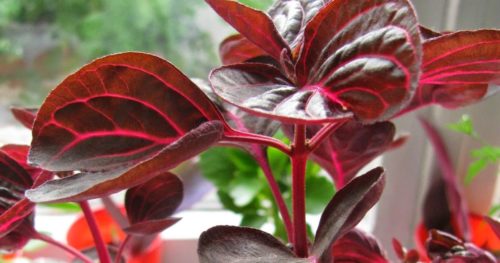
The plant has thin and delicate roots, therefore, the transplantation must be carried out by the transshipment method.
- prepare drainage and a new pot of slightly larger volume;
- pour a layer of drainage and soil onto the bottom of the flowerpot;
- slightly crush the old flowerpot, turn it over and, holding the plant with your hands, remove it together with an earthen lump;
- place irezine in the center of the new container, keeping the old earthen lump;
- pour new soil into the flowerpot, filling the voids and slightly compact it, but do not tamp it.
After transplanting, the plant requires abundant watering and spraying.
Iresine flower - description, recommendations for plant care
Irezine (lat. Iresine) or irezina is a herbaceous, shrub or semi-shrub perennial of the Amaranth family, originally from America, Australia, the Galapagos and Antilles.
The name of this houseplant is translated from Greek as "woolen", probably due to the abundant pubescence of its flowers and fruits.
The plant is not poisonous and cleans well and oxygenates the air in the room.
Flowering and fruiting
Leaves, reaching a length of 6 cm, are arranged oppositely on thin, straight or curly drooping shoots. They have a solid or scalloped edge, lanceolate, oval or heart-shaped, and a smooth, grooved surface. The color of the leaf plates is deep red, brown or crimson, they have dark streaks.
Small light yellow, white or lilac inflorescences are collected in spike-shaped forms. After flowering, box fruits remain on the plant.
Signs and superstitions
Irezine is best kept on the windowsill, and, according to the philosophy of Feng Shui, this serves as a barrier to negative energy entering the house.
Air temperature and humidity
The comfortable temperature for irezine is + 15–25 ° C in spring and summer, and + 15–20 ° C in winter.
The plant reacts negatively to both a decrease and an increase in temperature: if the thermometer drops below +12 ° C, irezine sheds leaves and rots, and an increase leads to drying out of the leaves.
It tolerates dry air well, but in hot weather needs a weekly spraying.
Pruning and shaping the crown
To increase branching in spring, pruning should be done at the end of winter.
To give the crown the desired shape, you need to pinch the upper and side shoots. This stimulates the growth of young shoots and increases bushiness.
Lighting and a comfortable place
The plant requires a lot of bright, but diffused lighting. It is better to put irezin on the sill of the south, south-west or south-east window.
To avoid burns due to direct sunlight on the leaves, the flower should be shaded in spring and summer.
Daylight hours should last at least 14, and preferably 16 hours, so in winter it is necessary to use additional artificial lighting.
Shade tolerance
With a lack of lighting, the leaves and stems of irezine turn pale, the shoots stretch out and the plant loses its decorative appearance.
What kind of pot do you need?
Iresine roots develop slowly, so the pot should not be too large.
The material from which it is made does not matter, the main thing is that there are drainage holes in it.
Expanded clay, small pebbles, broken brick or clay shards can be used as drainage.
What to do right after buying a flower?
After purchasing the plant, you should place it in a well-lit place and provide abundant and regular watering.
After 10-14 days required for adaptation, you need to transplant the irezine into a pot slightly larger than the previous one, replacing the soil as much as possible.
Reference! If the plant is purchased in winter, the flowerpot must be wrapped in thick paper during transportation or use a thermal bag.
What kind of soil is needed?
The soil should be light, air and moisture permeable, have low or neutral acidity (pH 6–7).
You can purchase ready-made universal soil for decorative deciduous plants in the store or prepare an earth mixture yourself by mixing:
- 4 parts of sod land;
- 4 pieces of leafy land;
- 2 parts of humus;
- 1 part sand;
- 1 part peat.
Transfer
If irezine is grown as an annual plant, no transplant is required.Perennials need to be transplanted every 2-3 years, when the root system will not have enough space in the flowerpot.
Also, a transplant is required 2 weeks after purchase, in case of root rot or when the plant is damaged by pests.
The plant has thin and delicate roots, therefore, the transplantation must be carried out by the transshipment method.
- prepare drainage and a new pot of slightly larger volume;
- pour a layer of drainage and soil onto the bottom of the flowerpot;
- slightly crush the old flowerpot, turn it over and, holding the plant with your hands, remove it together with an earthen lump;
- place irezine in the center of the new container, keeping the old earthen lump;
- pour new soil into the flowerpot, filling the voids and slightly compact it, but do not tamp it.
After transplanting, the plant requires abundant watering and spraying.
Plant care
Environmental conditions play a decisive role in plant life. The main ones are heat, light, air, water, food. Caring for your irezine at home is quite simple. It is necessary to take into account the main features:
- prefers bright light;
- optimal air temperature 16-25C;
- abundant watering;
- top dressing with organic or mineral fertilizers.
Top dressing
The irezine flower needs to be fed. The plant is fed several times a month with mineral or organic fertilizers.
Lighting
It is advisable to locate Linden's irezine and Herbst irezine on the windowsills of windows facing the south. Bright diffused light will be the main condition for proper care of the irezine.
Fertilizer
Irezine needs fertilization at certain times. Florists often use ordinary yeast. They are useful for the development of the root system, cause active plant growth. Yeast is capable of producing a huge amount of healing substances: phytohormones, B vitamins, auxins, cytokinins. Also, organic or mineral fertilizers purchased in any flower shop can be used as top dressing. They are brought in once a week. In the cold season, the plant grows slowly, so fertilizers are applied less often, once a month.
Watering
Water the plant with settled water at an air temperature. If the water is hard, use water purification filters. Correct, or better to say, timely watering is a matter of experience. If there is any doubt about the moisture content of the soil, you just need to poke your finger on the ground or scratch it. If the soil below the surface is damp, you may not need to water it yet. Excess moisture in the soil is just as undesirable as lack of moisture.
Air humidity
Dry air does not hurt the plant too much, but it is better to either spray it, increasing the humidity, or use an indoor humidifier.
Temperature
The optimum air temperature for plant development is + 16… + 25 ° C. At temperatures below + 12 ° C, the culture will begin to rot, it may die. At air temperatures above + 25 ° C, the plant may lose leaf turgor.
Possible problems
- falling leaves;
- shoots are thin, elongated.
These difficulties can be solved by adjusting watering and lighting. It is also necessary to pinch the shoots in a timely manner.
Irezine: description, cultivation and care
The irezine plant is a unique crop capable of being a tree, bush, grass and shrub. The family to which it belongs is called amaranth. Iresine is grown in northern and southern America. At the moment, it is possible to meet different types of culture in Australia.
Description
Plant height can reach sixty centimeters. The leaves are circular. Small flowers. In stores, they practically do not sell seeds or a ready-made irezine flower. Florists do not always know how to properly care for a crop and what conditions are favorable for it.
Types of irezine
The variety of the flower is diverse, but there are only two popular types.
- Irezine Herbst. It is a perennial plant. Height can be up to forty centimeters.The leaf blades are round and green in color. Irezine Herbst requires good indoor care.
- Irezine Linden. The maximum height for a shrub is fifty centimeters. The stems are reddish. The leaves can be six centimeters long. Their shape is oval. The shade is dark red. Flowers grow in groups, forming panicles.
Home care
Location. The place where the irezine will be located should be with bright lighting. But direct sunlight will adversely affect the plant.
In spring and summer, the sun is too hot, so you need to put the pot where the light hits, but the sun does not bake. In winter, artificial lighting is put on and left on until fifteen hours a day.
Temperature. Sixteen to twenty-five degrees is the normal temperature for a crop. Irezine feels comfortable at room temperature.
Air humidity. If the humidity is low, then this is not a global problem for the flower. But in the winter season, it is better to spray the plant with water.
Watering. Before watering, the water is defended for two to three days. Abundant watering affects the growth of the plant in a positive way.
When the soil dries up from above, you need to pour some water into it. In winter, it is not worthwhile to carry out increased watering.
But it is also impossible to bring the earth to complete drying. At a temperature of fifteen degrees, the plant should not be watered for some time.
- Sod soil;
- Peat;
- Humus;
- Sand;
- Deciduous soil.
Fertilizers. In order for the active growth and development of irezine to continue, it is sometimes necessary to carry out top dressing.
Mineral fertilizers and organic fertilizers are suitable for this. Add them to the soil once a week. In winter, the culture goes to rest, so there is no point in feeding it.
You can sometimes add them to maintain tone. The fertilizer concentration is halved. The process is carried out once a month.
Transfer. In three years, the roots of the plant grow to the maximum size that is allowed in a pot. At this time, you can transplant irezine.
A drainage layer is placed on the bottom of the container, otherwise the rhizome will rot.
Circumcision. The plant gives out shoots easily and at high speed. They need to be pinched. The process will not harm the plant, but it will give it a beautiful shape.
Reproduction of irezine
There are two ways to breed:
The easiest and fastest method is grafting. The top of the plant is cut off as a cutting. In length, it must be at least ten centimeters. It is better to carry out the process in early spring. During this time, irezine is preparing for development.
The cuttings are planted in the sand. Its temperature should not be less than twenty degrees. within ten days, the shoot will take root.
Growing problems
- If watering is carried out in the wrong amount, then the leaves of the plant will fall off.
- With the wrong lighting, the shoots of the crop become thinner and smaller.
- Untimely pinching leads to the fall of leaves from young shoots.
- You need to fight harmful insects with a shower for shoots from warm water.
Home care
Irezine adapts well to any conditions. For example, during the heating period it can adapt to low humidity.
Illumination
It is better to place the flower on the south, southwest and southeast window. But, although the plant loves bright light.
In summer, it is better to shade it from direct rays, and in winter, the total exposure to the light should be at least 15 hours. This can be achieved with artificial lighting.
It can tolerate direct sunlight, but the irezine flower should get used to them gradually.
If the plant grows indoors and is illuminated only by fluorescent lamps, then they should be turned on for at least 14 hours a day.
Temperature regime
The plant grows quietly at home at room temperature.In summer, irezine can withstand temperature fluctuations within 15-25 ° C, and in winter - 15-22 ° C, but not lower than 13 ° C.
If the plant grows outside, then it should be kept there until the first frost.
Fertilizer
It is necessary to intensively fertilize irezine during the growth period, which takes place in the plant from spring to early autumn. It should be fed every week using mineral or organic fertilizers.
Since the plant has a dormant period in winter, it should be fertilized less often and less. Approximately once a month, reducing the concentration of the fertilizer used by 2 times.
Watering
In the period from spring to early autumn, it is necessary to water the plant at least once every 2 days. Or focusing on the topsoil - as soon as it has dried, the plant should be watered immediately. The soil must be constantly moistened.
In the cold season, the flower should be watered more moderately - about once a week. But in no case is the substrate allowed to dry out. If in winter the temperature in the room where the flower is located drops below 16 ° C, then watering irezine should be even less frequent. You should be guided in the same way as in the summer on the topsoil - it should not be dry.
For watering, you should take soft or infused water (at least a day). It is good to use rainwater for irrigation.
Planting and transplanting
If the flower will be grown as an indoor perennial plant, then it is better to transplant once every 2-3 years. It is better to transplant in the spring.
Transplanting can be done earlier if the pot no longer holds the plant.
The plant prefers slightly acidic soil. For example:
- Peat, sand, deciduous and sod land, humus - 1: 1: 4: 4: 2.
- Garden land, leaf, perlite, peat - 1: 1: 1: 1.
- Sod and deciduous land, humus, sand - 2: 2: 2: 1.
During the warm season, the plant can be planted outdoors.
The main condition for transplanting is the presence of a drainage layer in the pot. It can be expanded clay or broken bricks.
Cropping flowers
The flower should be trimmed and pinched every year. After these procedures, the plant grows more branched and lush. These manipulations are carried out over the apical shoots of irezine. Pruning and pinching can be done all year round, but it is better in February for plant development in spring.
Reproduction
Most often, flower reproduction is carried out by cuttings, since this method is faster. To do this, you should:
- In the spring and summer, cut off the apical stalk about 5-8 centimeters long with 2 knots.
- Plant him in moistened sand.
- Cover with plastic.
- Maintain the temperature within 17-21 ° C.
- After the roots appear (7-10 days), transplant into a small pot.
- For the plant to branch better, it should be pinched twice as it grows.
- Purchase seeds.
- Sow them into a container with suitable soil.
- Cover with glass or plastic.
- Ventilate and humidify.
- Remove the cap as soon as sprouts appear.
- Place in a well-lit place.
- As soon as 3 (or more) leaves appear on the sprout, plant it separately.
Pests and diseases
Pests:
Green aphid - requires treatment with an insecticide, which contains pyrethrum.
Scratch. Appears due to waterlogging of the soil.
Also, the irezin plant is susceptible to such pests as whitefly and spider mites.
The main causes of flower disease are improper living conditions.
So, if the flower lacks lighting, then:
- leaves become small and fade;
- the stem is pulled out;
- foliage falls.
The cause of foliage falling can also be if pruning has not been done. But if the plant is already adult, this phenomenon is considered normal.
Consequences associated with watering:
- leaf discharge (lack or excess of watering);
- drooping leaves (drying out of the soil).
If the temperature is below normal (12 ° C):
- soft and drooping leaves and stems;
- leaf discharge;
- rotting roots.
If the temperature is increased, then the leaves lose their elasticity and droop.
Main varieties
The perennial plant is popular for its extraordinary red hue, and the leaves with teeth and borders are also popular. It does not need special conditions. Even a beginner can handle the cultivation. Indoors, an inflorescence resembling an ear appears very rarely. The most popular varieties are Herbst irezine and Linden irezine. By the way, the name translated from Greek means "woolen".

Decorative foliage irezine
This culture is not poisonous. It is believed that it perfectly cleans the air in the room, saturating the room with oxygen. The following will be considered types.
Irezine Herbst
In nature, this perennial variety grows in the tropics of Brazil. Occupies rain forests. Herbsta irezina is a herbaceous crop with red stems up to 40 cm in size. The characteristic leaves are round, heart-shaped in the upper part, dark purple in color. Red streaks complete the look of Iresine Herbstii.
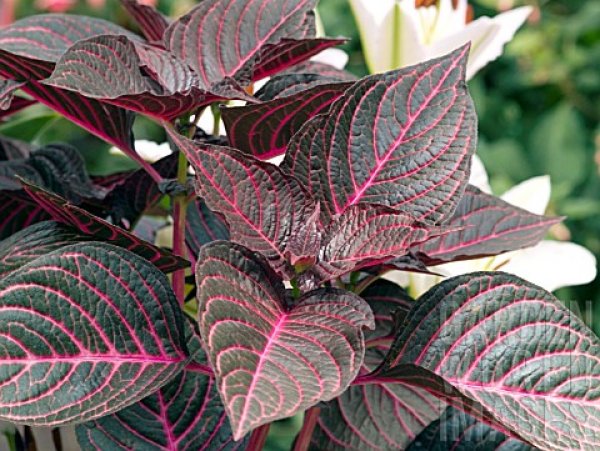
Irezine Herbst
Irezine Linden
The description of this species includes natural origin - the tropics of Ecuador. There, in humid forests, the natural conditions for the growth of Iresine lindenii. The property of having red stems is also inherent in this variety. Their height is 50 cm and more. The leaves, up to 6 cm in size, with crimson veins, also have a dark shade. When pruned, the plant branches out, giving young shoots.
And other varieties
It is necessary to mention the variety Aureoreticulata with red shoots, petioles. The leaf blades are green with gold or red veins. Wallisi, as another species, is a branchy but compact specimen. This variety has small leaves with a metallic red tint.
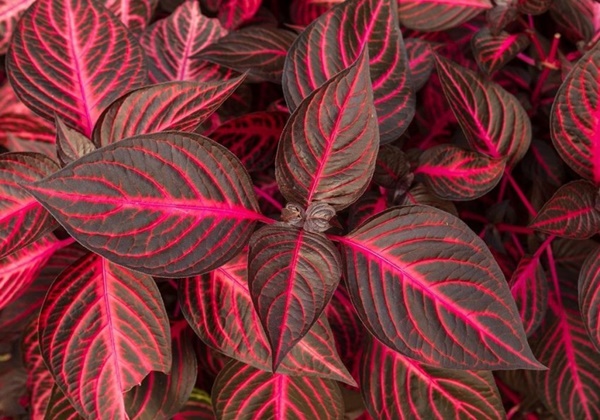
Irezine Linden with red stems
Diseases and pests
A perennial at home can suffer from attacks of the following pests:
- spider mite;
- aphid;
- whitefly;
- mealybug.
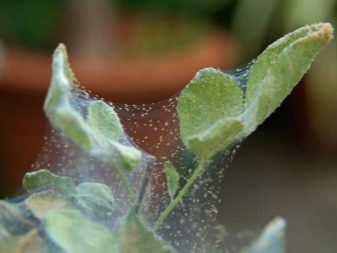
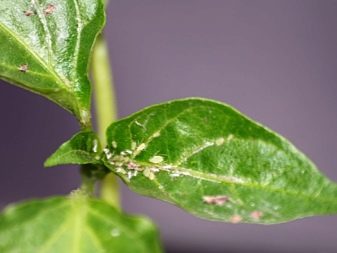
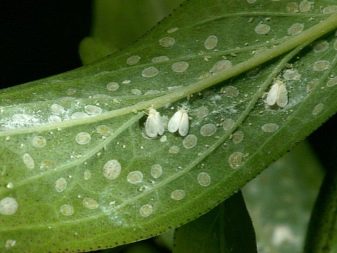

To destroy these dangerous insects, the grower should treat the culture with soapy water under a warm shower. This will help remove pests from the plant. Large individuals can be removed from the leaves with a cotton swab dipped in an alcohol solution.
Aphids and spider mites leave a white cobweb on the green mass, which will become the main sign of the presence of dangerous insects on the culture. With the repeated detection of individuals, as well as signs of damage to the culture, it would be more correct to carry out the treatment with store-bought insecticidal compositions.
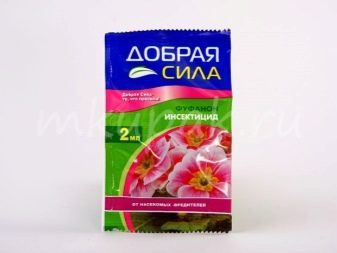
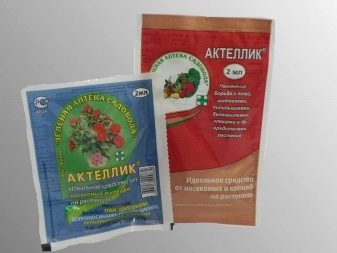
The greatest danger to irezine is the whitefly, since a large number of small flies appear near the plant, moving to different places.
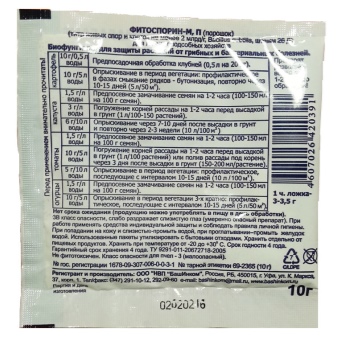
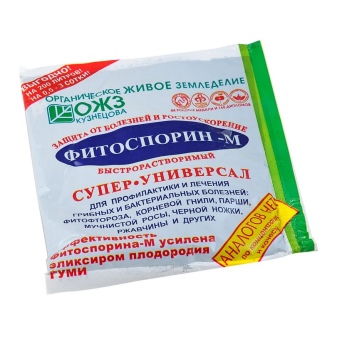
Irezine stands out for its good immunity to the main diseases of indoor crops. However, the root system of the plant is very sensitive to excess moisture, in light of which it can begin to rot. The fact that the rhizome has some problems, the culture will signal the grower with a deterioration in the appearance of the aerial part, and this can also be noticed during a planned transplant of a perennial.
For the treatment of root rot, it is recommended to change the flower pot along with the substrate; before replanting a diseased plant, all affected parts should be removed, after which, the roots should be treated with Fitosporin or another preparation with a similar composition.
For information on how to properly care for irezina, see the next video.
Pests. table
| Pest | Signs | Reason for appearance | How to fight |
| Aphid | Leaves curl, sticky discharge with a sooty fungus appears on them | Excess or no fertilizer, musty air, lack of light or moisture | Treatment with insecticides is required - "Aktellik", "Akarin" or "Fufanon" |
| Whitefly | The leaves curl, turn yellow and fall off, colonies of larvae are visible on the back of the leaf plates | Musty humid air and high temperatures | Remove pests mechanically, transplant the plant with maximum soil replacement, treat it with "Confidor" or "Aktellik" |
| Spider mite | Many white dots appear on the back of the leaves, parts of the plant are braided with cobwebs | Dry air and soil | Treat irezine, flowerpot and windowsill with soapy water, treat with Apollo, Akarin or Omite insecticides |
| Schervets | Affected leaves develop a light, waxy coating and sticky discharge. | Dry soil and air, the presence of dry leaves | Treat with "Fitoverm", "Calypso" or "Aktara" |
Leaf problems. table
| Problem | Cause | How to solve |
| The lower leaves are falling | In young specimens, this is due to a lack of light or a lack of timely pruning. | Place the plant in a well-lit place, prune elongated shoots |
| Drops the leaves | Excess or, conversely, lack of moisture | Set up watering regime |
| Leaves fade, they are dominated by a green tint | Lack of lighting | Place the flowerpot closer to the window or use additional artificial lighting |

